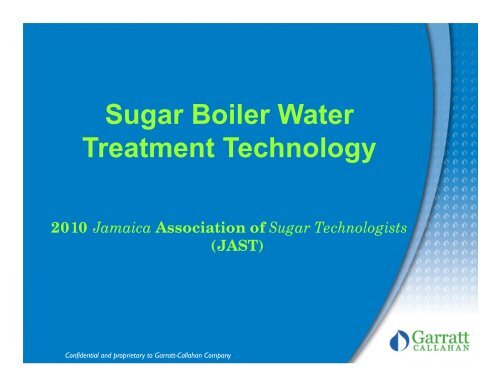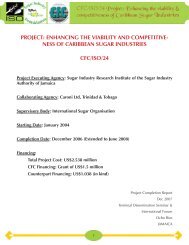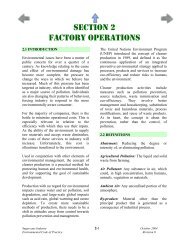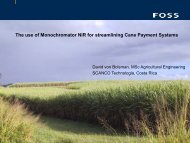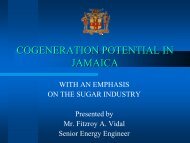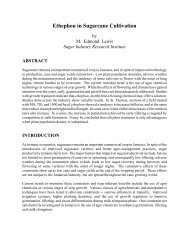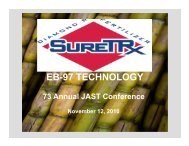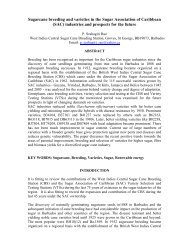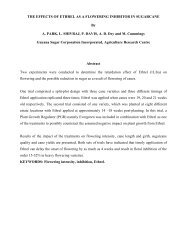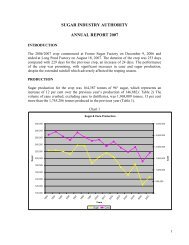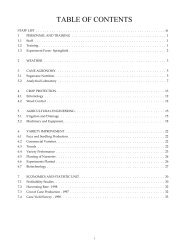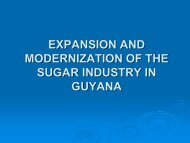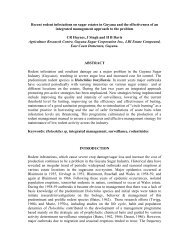Boiler Water.pdf - The Jamaican Sugar Industry
Boiler Water.pdf - The Jamaican Sugar Industry
Boiler Water.pdf - The Jamaican Sugar Industry
Create successful ePaper yourself
Turn your PDF publications into a flip-book with our unique Google optimized e-Paper software.
<strong>Sugar</strong> <strong>Boiler</strong> <strong>Water</strong><br />
Treatment Technology<br />
2010 Jamaica Association of <strong>Sugar</strong> Technologists<br />
(JAST)<br />
Confidential and proprietary to Garratt-Callahan Company
Bagasse <strong>Boiler</strong><br />
Confidential and proprietary to Garratt-Callahan Company
Typical Firetube <strong>Boiler</strong><br />
Confidential and proprietary to Garratt-Callahan Company<br />
3
<strong>Boiler</strong> Types<br />
<strong>Water</strong>-Tube Units<br />
– <strong>Water</strong> passes through (inside) tubes.<br />
– Used in power generation and industrial process steam.<br />
– Used for high pressure and high steam demand applications,<br />
also used with low demand application too.<br />
– Best suited for large plants with steam turbines.<br />
– Very high and fast steaming rate, with low contained volume<br />
of water.<br />
Confidential and proprietary to Garratt-Callahan Company<br />
4
<strong>Boiler</strong> Types<br />
<strong>Water</strong>-Tube Units<br />
– Has large square feet of heating area.<br />
– Responds quickly to fluctuating steam loads.<br />
– Requires more care in water treatment, as tubes can get<br />
plugged with scale, inhibiting circulation.<br />
– Has a steam drum and mud drum with interconnecting tubes.<br />
– Must be treated with preconditioned water. e.g. Softened.<br />
Confidential and proprietary to Garratt-Callahan Company<br />
5
<strong>Boiler</strong> Types<br />
<strong>Water</strong>-Tube Unit Circulation<br />
Confidential and proprietary to Garratt-Callahan Company<br />
6
<strong>Boiler</strong> Types<br />
<strong>Water</strong>-Tube Unit Types<br />
7
<strong>Boiler</strong> Types<br />
<strong>Water</strong>-Tube Unit Types<br />
8
<strong>Boiler</strong> Types<br />
<strong>Water</strong>-Tube Unit Types<br />
9
<strong>Boiler</strong> System Overview<br />
Makeup<br />
(Pretreatment)<br />
Feed <strong>Water</strong><br />
Tank or<br />
Deaerator<br />
Condensate<br />
Load<br />
Steam<br />
Ion<br />
Exchange<br />
Feedwater<br />
Pump<br />
<strong>Boiler</strong><br />
Surface<br />
Blowdown<br />
Bottom<br />
Blowdown<br />
10
Condensate<br />
• Condensate from the evaporators, pans and turbines supply in excess<br />
of 150% of the boiler feed water<br />
• Condensate can be contaminated with sugar<br />
• <strong>Sugar</strong> contamination<br />
– Drops the pH to acid levels under pressure.<br />
– Low pH feed water corrodes the tubes.<br />
– Corroded iron is laid down as scale on the tubes.<br />
– <strong>Sugar</strong> can caramelize and be laid down as carbon scale on the<br />
tubes<br />
Confidential and proprietary to Garratt-Callahan Company
Pre-Treatment Systems<br />
Sodium Cycle Cation Exchange<br />
Influent<br />
Ca<br />
Regenerant<br />
NaCl<br />
Mg<br />
2Na<br />
2HCO 3<br />
Ca<br />
Mg<br />
2Na<br />
SiO 2<br />
SO 4<br />
2Cl<br />
2NO 3<br />
Regenerant Waste<br />
Strong Acid<br />
Cation<br />
Exchanger<br />
Sodium<br />
Cycle<br />
To Process<br />
NaHCO<br />
Na 2 CO 3<br />
Na 2 SO 4<br />
NaCl<br />
NaNO 3<br />
SiO 2<br />
CaCl 2<br />
MgCl 2<br />
NaCl<br />
Confidential and proprietary to Garratt-Callahan Company<br />
12
Make-up <strong>Water</strong><br />
Softener<br />
13
Elution Study<br />
•Use a graduated cylinder and<br />
a Salometer<br />
•Take samples every 5<br />
minutes and plot curve.<br />
14
Deaerating Heaters - Oxygen<br />
Removal .005 cc/L 7 pbb.<br />
Confidential and proprietary to Garratt-Callahan Company<br />
15
Dissolved oxygen:<br />
– Can cause corrosive pitting attack on<br />
feed water/boiler surfaces.<br />
– Usually caused by dissolved oxygen<br />
gas brought in by makeup water.<br />
– Best removed with a deaerator<br />
(removes O 2 down to 7 ppb).<br />
– Oxygen scavengers are used to react<br />
with remaining amounts of oxygen.<br />
Confidential and proprietary to Garratt-Callahan Company<br />
16
Deaerating Heaters<br />
• Mechanical Deaeration<br />
– Spray Type<br />
– Tray Type<br />
– Atomizing Type<br />
Confidential and proprietary to Garratt-Callahan Company<br />
17
Deaerator<br />
Confidential and proprietary to Garratt-Callahan Company<br />
18
Pressure vs. Temperature<br />
• For every 1 # pressure there is a loss or<br />
gain of 3 o F temperature<br />
• 5 # pressure = 227 o F<br />
• At 5 # pressure or 227o F the deaerator<br />
removes O 2 down to 7 ppb<br />
• Insure that you have gages to measure<br />
both pressure and temperature<br />
Confidential and proprietary to Garratt-Callahan Company<br />
19
Deaerating Heaters<br />
• Mechanical malfunction or flow control problems result in poor<br />
Oxygen removal.<br />
• Causes of Improperly operating deaerators.<br />
– Inadequate venting.<br />
– Inadequate quantities of steam or steam pressure fluctuations.<br />
– Wide fluctuations in feed water flow.<br />
– Flow rates outside design specifications.<br />
– Malfunctioning spray nozzles, missing, plugged or broken.<br />
– Malfunctioning trays, missing, plugged or broken.<br />
• Problems will almost always manifest as a broad temperature<br />
differential (>2°F; 1°C) between dome and storage section.<br />
Confidential and proprietary to Garratt-Callahan Company<br />
20
Oxygen Removal - Reducing Agents<br />
and Passivating Agents.<br />
•Reducing Agents: Include a wide variety of oxygen scavengers and<br />
passivating agents, reducing agents are electron donors.<br />
Oxygen scavengers react with dissolved oxygen directly.<br />
Passivating agents react with iron and copper to form a<br />
protective oxide films even in the presence of up to 5 pbb<br />
dissolved oxygen.<br />
Confidential and proprietary to Garratt-Callahan Company<br />
21
Oxygen Removal / Passivation<br />
Sodium Sulfite (or Bisulfite)<br />
Oxygen Scavenger:<br />
2SO 3= + O2 2SO 4<br />
=<br />
No Passivating Properties<br />
Control Range: <strong>Boiler</strong> <strong>Water</strong><br />
25-50 ppm 1250 psig<br />
Non-volatile, adds TDS, Can Poison Process catalysts.<br />
Not for use in attemperating water or standby in nondrainable<br />
superheaters.<br />
Confidential and proprietary to Garratt-Callahan Company<br />
22
Oxygen Removal / Passivation<br />
Oxygen Scavenger:<br />
Hydrazine<br />
N 2 H 4 + O 2 2H 2 O +N 2<br />
Passivating Properties:<br />
N 2 H 4 + 6Fe 2 O 3 4Fe 3 O 4 + 2H 2 O + N 2<br />
Control Range: <strong>Boiler</strong> <strong>Water</strong><br />
20-50 ppb Feedwater at economizer inlet.<br />
Passivates iron and copper, Does not increase TDS,<br />
non-volatile, suspect carcinogen, and breaks down to<br />
ammonia.<br />
Confidential and proprietary to Garratt-Callahan Company<br />
23
Oxygen Removal / Passivation<br />
Diethylhydroxylamine (DEHA)<br />
Oxygen Scavenger:<br />
4(C 2 H 5 ) 2 NOH + 9 O 2 8 CH 3 COOH+ 2N 2 + 6H 2 O<br />
Passivating Properties:<br />
2(C2H5)2NOH + 27Fe 2 O 3 18Fe 3 O 4 + 4CH 3 COOH + 3H 2 O + N<br />
Control Range: <strong>Boiler</strong> <strong>Water</strong><br />
100-150 ppb Feedwater at economizer inlet.<br />
Very similar to hydroquinone but: generates very little ammonia,<br />
volatile, and not as thermally stable. Volatizes with steam.<br />
Confidential and proprietary to Garratt-Callahan Company<br />
24
Oxygen Removal / Passivation<br />
• Chemical Feed Considerations<br />
– Use stainless steel feed systems.<br />
– Use floating lids to minimize loss of products.<br />
– Use high purity, warm condensate or deaerated water<br />
to prepare feed solutions. Never use cold water.<br />
– Limit agitation of the feed solution to 1-2 minutes<br />
– If there is no attemperation (control of superheated<br />
steam temperature), any of the products may be fed to<br />
the deaerator storage section, just below the waterline.<br />
– With attemperation, all sulfite products, are to be<br />
injected after attemperation takeoff.<br />
Confidential and proprietary to Garratt-Callahan Company<br />
25
Dissolved Oxygen<br />
Analyzer<br />
<strong>The</strong> Series μAI-9060 Dissolved Oxygen<br />
System is a state-of-the-art<br />
microprocessor-based instrument<br />
package developed specifically for use<br />
in measuring low and high<br />
concentrations of dissolved oxygen in<br />
the power, desalination, and<br />
petrochemical industry.<br />
•Disposable DO Sensor<br />
•Automatic Calibration<br />
•Auto Range Switching<br />
Confidential and proprietary to Garratt-Callahan Company<br />
26
Internal <strong>Boiler</strong> <strong>Water</strong><br />
Treatments<br />
Confidential and proprietary to Garratt-Callahan Company<br />
27
Internal <strong>Boiler</strong> <strong>Water</strong> Treatment Programs<br />
• Carbonate Cycle<br />
• Phosphate-hydroxide<br />
• Coordinated pH-phosphate<br />
• Phosphate and polymer<br />
• Chelant Treatment and/or chelant polymer<br />
• All-polymer<br />
Confidential and proprietary to Garratt-Callahan Company<br />
28
Internal <strong>Boiler</strong> <strong>Water</strong> Treatment Programs<br />
• Chelant Treatment and/or chelant polymer<br />
– Chelant react with residual divalant metal ions<br />
to form soluble complexes.<br />
– <strong>The</strong> complexes are removed through continues<br />
blowdown.<br />
– Inconsistency in boiler water chemistry create an<br />
imbalance:<br />
• Excessive chelant will result in attack on boiler<br />
tubes.<br />
• <strong>The</strong> presents of dissolved oxygen will result in<br />
greater deposition problems.<br />
Confidential and proprietary to Garratt-Callahan Company<br />
29
Internal <strong>Boiler</strong> <strong>Water</strong> Treatment Programs<br />
• All-polymer<br />
– Polymers maintain clean heat transfer surfaces in<br />
several ways: scale inhibition, metal ion<br />
solubilization, crystal modification, and particulate<br />
dispersion.<br />
– Polymer inhibit scale formation by disrupting the<br />
growth of deposits.<br />
– Carboxylated polymers will form a soluble complex<br />
with feed water hardness.<br />
– Polymers cannot be tested in process for residual,<br />
therefore inbalances in boiler water chemistry<br />
create dosing problems<br />
Confidential and proprietary to Garratt-Callahan Company<br />
30
Crystal Modification
Crystal Modification
Internal <strong>Boiler</strong> <strong>Water</strong> Treatment Programs<br />
• Phosphate and polymer<br />
– Phosphate precipitation.<br />
– Polymers disperse particles.<br />
– Polymers alter particle surface area and<br />
surface charge to non scaling.<br />
– Can clean scaled boiler online.<br />
– Can be measured in process<br />
Confidential and proprietary to Garratt-Callahan Company<br />
33
THE HIDDEN COSTS OF BOILER<br />
WATER TREATMENT<br />
AN EVALUATION OF BOILERS IN THE<br />
LOUISIANA SUGAR INDUSTRY<br />
James A. Cuddihy, Jr., Walter J. Simoneaux, Robert N. Falgout, and James<br />
S. Rauh<br />
34
Do you have<br />
<strong>Boiler</strong> Problems?<br />
Confidential and proprietary to Garratt-Callahan Company<br />
35
Borescope Observation Form<br />
Facility:<br />
Date 3/17/2004<br />
<strong>Boiler</strong> Clean Slightly Moderately Heavily Chipped Pit Under<br />
Tube Scaled Scaled Scaled Scaling Corrosion Scale<br />
Corrosion<br />
<strong>Boiler</strong> #<br />
Ctr Tube X Iron Oxide X<br />
Dn Cmr<br />
X<br />
Up Comr X X<br />
Ctr Tube X X<br />
Up Comr X X<br />
Dn Cmr X X<br />
<strong>Boiler</strong> #<br />
Ctr Tube X X<br />
Dn Cmr X X<br />
Up Cmr X X<br />
Ctr Tube X X<br />
Up Cmr X X<br />
Dn Cmr X X<br />
<strong>Boiler</strong> #<br />
Ctr Tube<br />
X<br />
Dn Cmr<br />
X<br />
Up Cmr<br />
X<br />
Ctr Tube X X<br />
Up Cmr X X X<br />
Dn Cmr X X<br />
<strong>Boiler</strong> #<br />
Ctr Tube<br />
X<br />
Dn Cmr X X<br />
Up Cmr<br />
X<br />
Ctr Tube<br />
36
Borescope Summary<br />
Mill Clean Slightly Moderately Heavily Chipped Pit Under<br />
Tube Scaled Scaled Scaled Scaling Corrosion Scale<br />
8 Mills / 43 <strong>Boiler</strong>s / 222<br />
Tubes 1/32" 1/16"+ Corrosion<br />
A 3 4 10 2 1 3<br />
B 6 10 12 9 3 7 7<br />
C 3 8 16 7 15<br />
D 3 15 1 2 3<br />
E 1 1 18 3 1 1<br />
F 5 12 19 2 26 4<br />
G 2 1 7 25 7 11 20<br />
H 9 12 5 5 6 5<br />
Total 24 51 55 92 24 54 58<br />
Average 10.8% 23.0% 24.8% 41.4% 10.8% 24.3% 26.1%<br />
37
Scale/Deposit Formation<br />
• <strong>The</strong> primary reason for deposit and scale formation in steam generating systems<br />
is the fact that the solubility of many of the deposit forming salts decreases with<br />
an increase in temperature and concentrations. <strong>The</strong> water constituents usually<br />
responsible for these deposits are:<br />
Calcium (Ca)<br />
Bicarbonate (HCO3)<br />
Sulfate (SO4)<br />
Silicate (SiO2)<br />
Magnesium (Mg)<br />
Iron (Fe)<br />
Carbonate (CO3)<br />
Phosphate (PO4)<br />
Confidential and proprietary to Garratt-Callahan Company<br />
38
Light Scale (1/32”)<br />
Confidential and proprietary to Garratt-Callahan Company<br />
39
Light Scale (1/32”)<br />
40
Calcium Phosphate Scale<br />
Typical 1/16” Deposit<br />
Confidential and proprietary to Garratt-Callahan Company<br />
41
Heavy Scaling<br />
Confidential and proprietary to Garratt-Callahan Company<br />
42
Heavily Scaled<br />
Confidential and proprietary to Garratt-Callahan Company<br />
43
Heavy Scale<br />
Confidential and proprietary to Garratt-Callahan Company<br />
44
Heavy Scaling / Corrosion<br />
Confidential and proprietary to Garratt-Callahan Company<br />
45
Chip Scale<br />
Confidential and proprietary to Garratt-Callahan Company<br />
46
Chip Scale<br />
Confidential and proprietary to Garratt-Callahan Company<br />
47
Pit Corrosion<br />
Confidential and proprietary to Garratt-Callahan Company<br />
48
Pit Corrosion<br />
Confidential and proprietary to Garratt-Callahan Company<br />
49
Pit Corrosion<br />
Confidential and proprietary to Garratt-Callahan Company<br />
50
Scale & Corrosion<br />
Confidential and proprietary to Garratt-Callahan Company<br />
51
Under Deposit Corrosion<br />
Confidential and proprietary to Garratt-Callahan Company<br />
52
Under Deposit Corrosion<br />
Confidential and proprietary to Garratt-Callahan Company<br />
53
Under Deposit Corrosion<br />
Confidential and proprietary to Garratt-Callahan Company<br />
54
EFFECTS OF DEPOSIT AND<br />
SCALE FORMATION<br />
1. Heat transfer is retarded<br />
• <strong>Boiler</strong> tube metal temperatures increase. <strong>The</strong> approximate<br />
softening temperature of boiler tube metal is about 900 0 F. If<br />
heat retardation of boiler deposits causes this temperature to<br />
be reached, tube softening and rupture will occur.<br />
• Even when deposit build-up may not be sufficient to cause<br />
tube failure, their insulating effect may still result in reduced<br />
boiler operation efficiency and energy wastage by<br />
allowing excessive heat to exit the boiler with the stack gas.<br />
Confidential and proprietary to Garratt-Callahan Company<br />
55
2. Deposits in boilers can reduce circulation through tubes.<br />
• This encourages further deposit formation due to the<br />
reduction of the washing effect of circulating water on solids<br />
concentrating at heat transfer surfaces.<br />
• Since deposits are poor conductors of heat, they retard heat<br />
transfer from combustion gases.<br />
Confidential and proprietary to Garratt-Callahan Company<br />
56
3. Deposits can also create differential corrosion cells<br />
beneath their surfaces (under scale corrosion).<br />
• <strong>The</strong> result is localized corrosion or pitting. If such<br />
corrosion is severe, boiler metal can become thinned and<br />
weakened, resulting in ruptures due to internal boiler<br />
pressure.<br />
Confidential and proprietary to Garratt-Callahan Company<br />
57
Fuel Value of Bagasse<br />
• 1 mt fresh bagasse fiber<br />
– (50% moisture)<br />
• 2.2 barrels of fuel oil<br />
– (assuming 58% boiler efficiency)<br />
• 13,200 cu ft of natural gas<br />
– (assuming 75% boiler efficiency)<br />
Confidential and proprietary to Garratt-Callahan Company<br />
58
Cost of Scale Formation<br />
Assumptions<br />
• Mill grinds 10,000 TC/Day<br />
• Bagasse = 33% of cane weight<br />
• Fuel Prices<br />
– Fuel oil = $100.00 /barrel<br />
• 1 ton of bagasse = 2.2 barrels of oil<br />
– Natural gas = $7.50 / mcf<br />
• 1 ton bagasse = 13.2 mcf<br />
Confidential and proprietary to Garratt-Callahan Company<br />
59
What is the Cost of Scale?<br />
Mill grinding 10,000 tons cane per day<br />
Tons bagsse 3,300<br />
Scale % Fuel Tons Bagasse Fuel Oil Natural Gas<br />
Thickness Wasted Wasted Cost Cost<br />
($100 x 2.2 x bwt) ($7.50 x 13.2 x bwt)<br />
1/32" 7% 231 $50,820 $22,869<br />
1/25" 9% 297 $65,340 $29,403<br />
1/20" 11% 363 $79,860 $35,937<br />
1/16" 13% 429 $94,380 $42,471<br />
1/11" 15% 495 $108,900 $49,005<br />
1/9" 16% 528 $116,160 $52,272<br />
Confidential and proprietary to Garratt-Callahan Company<br />
60
Additional Costs of Scale Formation<br />
• Production Downtime<br />
• Mechanical Cleaning of <strong>Boiler</strong>s<br />
• Acid Cleaning of <strong>Boiler</strong>s<br />
• Tube Replacement<br />
• Increased Use of <strong>Boiler</strong> <strong>Water</strong> Chemicals<br />
Confidential and proprietary to Garratt-Callahan Company<br />
61
Field Analysis<br />
FIELD ANALYSIS Plant of: Date: November 19,2003<br />
AND Address:<br />
SERVICE REPORT Attention:<br />
Copy To:<br />
Midland Copy To:<br />
SAMPLE<br />
FROM<br />
pH P M OH Cl TH Ca<br />
H<br />
Fe Cu mmho<br />
s<br />
SO 3<br />
PO 4<br />
Mo O-<br />
N 2<br />
H 4 P<br />
NO 2<br />
Feedwater 12.4 60 64 20 0 .14 .02 280 2.5 0.0<br />
<strong>Boiler</strong> #G 12.7 76 136 16 56 28 3.33 .07 2600 12.5 .10<br />
<strong>Boiler</strong> #A 12.1 28 60 4 16 84 4.00 1.94 1200 5.0 7.9<br />
<strong>Boiler</strong> #B<br />
<strong>Boiler</strong> #C<br />
<strong>Boiler</strong> #D<br />
<strong>Boiler</strong> #E<br />
12.6<br />
12.4<br />
11.8<br />
11.9<br />
80 124 36 40 92 4.10 2.25 2800 15.0 0.0<br />
60 115 5 24 28 4.20 4.60 2300 12.5 0.0<br />
20 28 12 16 20 3.56 4.63 660 5.0 0.6<br />
24 40 8 8 68 3.06 .77 800 5.0 1.9<br />
<strong>Boiler</strong> #F 12.5 64 76 52 16 80 4.21 2.34 2200 2.5 0.1<br />
Control<br />
Range<br />
9.5<br />
11.<br />
5<br />
700<br />
150<br />
300<br />
0<br />
0.1<br />
0<br />
.0<br />
5<br />
2000<br />
3000<br />
20<br />
40<br />
2<br />
0<br />
4<br />
0<br />
Confidential and proprietary to Garratt-Callahan Company
<strong>Boiler</strong> Tube<br />
Scale Deposit Analyses<br />
Constituent<br />
% Dry Weight<br />
Tube #1 Tube #2<br />
Calcium Phosphate 10.7 15.0<br />
Calcium Carbonate 5.0 0.0<br />
Iron Oxide 65.0 51.8<br />
Copper II Oxide 10.0 11.2<br />
Magnesium Hydroxide 5.8 7.2<br />
Magnetic Yes Yes<br />
Confidential and proprietary to Garratt-Callahan Company<br />
63
Hawaiian <strong>Sugar</strong> Mill<br />
• Produces 60,000 tons raw sugar annually<br />
• Generates electric power for HELCO utility grid<br />
BOILER PLANT - STARTUP 1972<br />
• Babcock & Wilcox - Sterling, two drum design<br />
• Operating Pressure 1200 psi<br />
• 825 o F Superheated Steam<br />
• <strong>Boiler</strong> Rating 375,000 lbs steam per hour<br />
• Operating Load 330,000 lbs steam per hour (average)<br />
• Turbine Generator - 23,800 kW<br />
• 160 psi Extraction Steam Used For Factory Operation<br />
• Condensate Return Averages 85%<br />
• Demineralized Makeup<br />
• Cochrane Deaerator<br />
Confidential and proprietary to Garratt-Callahan Company<br />
64
NEW DIRECTIONS IN BOILER<br />
WATER TREATMENT<br />
• Phosphate Polymer Technology<br />
• combines internal phosphate treatment with the<br />
latest in synthetic polymer technology<br />
• blends of polymers formulated to deal with specific<br />
problems<br />
• enhanced thermal stability for high pressure boiler<br />
performance<br />
• gives improved phosphate stability for hardness<br />
control<br />
• disperses metal oxides and transports them<br />
through the system<br />
• provides on-line removal of deposition - including<br />
metal oxides<br />
Confidential and proprietary to Garratt-Callahan Company<br />
65
CHEMICAL TREATMENT<br />
PROGRAM RESULTS<br />
• Tube failure in old section of arch tubes<br />
• <strong>Boiler</strong> inspected:<br />
• one leak found in a waterwall tube<br />
• lesser amounts of loose deposit found in boiler<br />
• significant removal of old deposit on waterwall<br />
tubes<br />
• new (replaced) arch tube sections deposit free<br />
Confidential and proprietary to Garratt-Callahan Company<br />
66
• Tube samples<br />
• Arch (Nose) tube and waterwall tube<br />
Confidential and proprietary to Garratt-Callahan Company<br />
67
• Sections cut from waterwall tube<br />
• A - “bracelet” distorted<br />
• B - “hot” side<br />
• C - “cold” side<br />
Confidential and proprietary to Garratt-Callahan Company<br />
68
• 1 inch length tube “bracelet”<br />
• Distorted to show extent of deposit<br />
Confidential and proprietary to Garratt-Callahan Company<br />
69
• Original deposit condition<br />
• <strong>Water</strong>wall tube removed<br />
70
• 8X magnification<br />
• Original deposit on waterwall tube<br />
removed<br />
Confidential and proprietary to Garratt-Callahan Company<br />
71
• Deposit condition after 12 months on Polymer<br />
Program<br />
• Adjacent waterwall tube removed<br />
• Significant removal of old deposit<br />
Confidential and proprietary to Garratt-Callahan Company<br />
72
• 8X magnification<br />
• Diminished deposit on adjacent<br />
waterwall tube removed after 1 year<br />
Confidential and proprietary to Garratt-Callahan Company<br />
73
• New Arch tube installed<br />
• No adhering deposits<br />
Confidential and proprietary to Garratt-Callahan Company<br />
74
• 8X magnification<br />
• Clean arch tube after one year<br />
Confidential and proprietary to Garratt-Callahan Company<br />
75
Identifying <strong>Sugar</strong> Incursions<br />
• Conductivity meters cannot measure sugar in boiler<br />
feed water<br />
– You measure the carryover solids (i.e.; ammonia,<br />
non-sugars, organics)<br />
• Tracers and florescence light have not proved effective<br />
at identifying sugar incursions at ppm.<br />
Confidential and proprietary to Garratt-Callahan Company
Conductivity Meter Setup<br />
1. Install automatic dump valve prior to feed water storage tank<br />
2. Place conductivity probe in condensate line prior to the dump<br />
valve<br />
1. False sugar positives will occur during stop and go<br />
production as ammonia will buildup and set-off the alarm<br />
3. Set the conductivity valve set-point just above the background<br />
reading<br />
4. When the conductivity meter sets off the alarm, the dump valve<br />
should open automatically<br />
5. Factory personnel should test the water with Alpha-Naphthol<br />
Test<br />
1. Find the point of contamination or if it was a false positive,<br />
close the automatic valve.<br />
Confidential and proprietary to Garratt-Callahan Company
Steam Treatment: <strong>Sugar</strong> <strong>Industry</strong><br />
Due to the ammonia carryover from the organics in<br />
the evaporators, the residual effect maintains a<br />
high enough pH so that amines are not normally<br />
needed for steam line treatment.<br />
Confidential and proprietary to Garratt-Callahan Company<br />
78
Chemical Feeding Methods<br />
and Feed Points<br />
Treatment Feedpoint<br />
Sulfite 1<br />
Hydrazine 1<br />
Sludge Conditioner 2<br />
Chelant<br />
3 or 3a<br />
Feed <strong>Water</strong><br />
Tank or<br />
Deaerator<br />
1<br />
2<br />
Condensate<br />
4<br />
Load<br />
Steam<br />
Phosphate 4<br />
Neutralizing Amine 2,4,or 5 (a)<br />
3 3a<br />
5<br />
Filming Amine<br />
5 or 3a<br />
Economizer<br />
<strong>Boiler</strong><br />
(a)<br />
Must be diluted with<br />
condensate of feedwater.<br />
Feedwater<br />
Pump<br />
Surface<br />
Blowdown<br />
Bottom<br />
Blowdown
<strong>Boiler</strong> Blowdown<br />
• Surface blowdown<br />
– Removes dissolved solids, controls the<br />
cycles of concentration.<br />
• Bottom blowdown<br />
– Removes suspended solids, normally done<br />
once a shift for 5-10 seconds. Do not use to<br />
control cycles.<br />
Confidential and proprietary to Garratt-Callahan Company<br />
80
Anti-Foams<br />
1. Counteracts the surfactant effect of High TDS,<br />
suspended solids, oil, or other organics.<br />
2. May be more economical than increased<br />
blowdown or additional external treatment.<br />
3. Frequently reduce fuel consumption by<br />
permitting lower blowdown rates while producing<br />
high quality steam.<br />
4. Will only help with normal entrainment. Will<br />
not prevent volatile (Silica) carryover.<br />
Confidential and proprietary to Garratt-Callahan Company<br />
81
Anti-Foams<br />
•Two types:<br />
•Polyglycols<br />
•Use in all boilers.<br />
•Feed directly to boiler drum.<br />
•Silicone<br />
•Use in boilers with low operating pressure.<br />
•Feed directly to boiler drum.<br />
•Use in very small applications.<br />
Confidential and proprietary to Garratt-Callahan Company<br />
82


